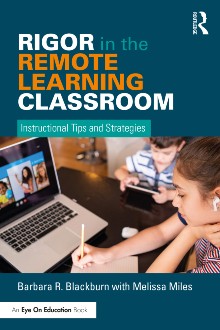Conveying Your High Expectations Remotely
 By Barbara R. Blackburn
By Barbara R. Blackburn
Teachers’ beliefs, reflected in actions, demonstrate their expectations for their students. In other words, teachers treat students differently dependent on “expectancy,” or what they expect.
Although the difference in treatment may not be intentional, students notice it and will seek to meet those expectations no matter how high or low they are (Williamson, 2012).
How do our behaviors reflect our expectations, particularly in a remote classroom? For example, teachers tend to probe students more if they have high expectations. This sends a clear message that, “I know you know the answer and if I give you hints, you will formulate a reasonable response.”
You also want to probe for more information if they answer at a basic level. Probing can happen verbally in a live presentation, such as Zoom or Google Hangouts, or in writing when posting assignments, perhaps in Canvas.
Teachers also demonstrate expectations in the types of assignments or activities implemented in the classroom. My stepson described to me that most classes just ask you factual questions; honors classes also ask why. Remember that higher order questions are for all students, not just those who are considered advanced. There are a variety of other teacher behaviors related to student expectations.
Low Expectation Behavior by Teachers
Let’s look at typical behaviors related to the low and high expectations of students. Teachers who have low expectations for students ask fewer, lower level and less specific questions, provide less wait time, and probe at a minimal level. They also accept, and even praise, low level and surface level responses, and, at times, provide answers for students.

One example is “What are two ways in which the vast desert regions of Southwest and Central Asia affect the lives of the people who live there?” Instead of “Which of the two deserts, the Gobi or the Karakum, make surviving easier for those who might live there and why?”
This is particularly evident when we give students a guide in which students simply fill in the blanks while looking at slides or video. My colleague Melissa Miles and I hav seen guides for online learning that only include questions such as “What is…” “When did…” or “Who said…” Low expectations are also reflected when we provide feedback that praises incomplete or incorrect answers, without asking them to finish or rework their responses.
High Expectation Behavior by Teachers
On the other hand, teacher actions that reflect high expectations use the opposite behaviors. For example, in a synchronous video session, teachers call on all students, especially struggling students, more often, and provide more wait time. Their questions are more specific, which provide a better chance for students to answer correctly, and they are more challenging.
This also parallels when you post questions on a shared document platform such as Google Docs. For example, rather than just asking students to state the main idea or write their opinion of a theme, a more rigorous question is “What is the theme of Treasure Island? Make sure to use details from the text to support your choice. Treasure Island was written over 100 years ago. Justify whether this theme applies to today. Provide an example from modern life to validate your answer.”
Notice that this question moves beyond a basic analysis of the theme to justifying an answer and moves beyond the text to real life applications. This type of question also requires a deeper understanding of the content.
Note this does not mean that you cannot provide support for student learning. Many will need scaffolding to be successful with higher expectations. However, rather than giving the basic fill-in-the-blank questions, provide a structured, but more open-ended, graphic organizer that will help them organize their thoughts.
High expectation instruction also uses more complex modes of presentation. I’ve seen Zoom lessons with very basic Powerpoints, where students are asked to copy the information (or the Powerpoint is posted on an electronic resource page).
Once again, too often they are then asked basic questions that simply require them to look at the information and write their response. Instead, ask students to take the information from the slide, research for another source, and combine the information to analyze the information in a complex manner.
Remote learning provides opportunities for students to work independently and move beyond the information provided, and we should take advantage of this. Additionally when presenting in a synchronous setting, take advantage of features such as breakout rooms and chats for students to immediately apply their learning.
Finally, provide positive feedback focused on higher levels of responses, while supporting those who are making progress. For example, “I noticed you are digging deeper for information. That is exactly what you need to do. You’ll be able to use that information to justify your perspective, which is the next step.”
A Final Note
Demonstrating high expectations in a remote classroom simply means adapting what you do in your physical classroom to new conditions. Continue to increase the complexity and levels of your questions, tasks, and assignments, and positively reinforce students as they rise to the challenge.

Her newest book, with Melissa Miles, Rigor in the Remote Learning Classroom, was published September 17, 2020.
A nationally recognized expert in the areas of rigor and motivation, she collaborates with schools and districts for professional development. Barbara can be reached through her website or her blog. Follow her on Twitter @BarbBlackburn.




























